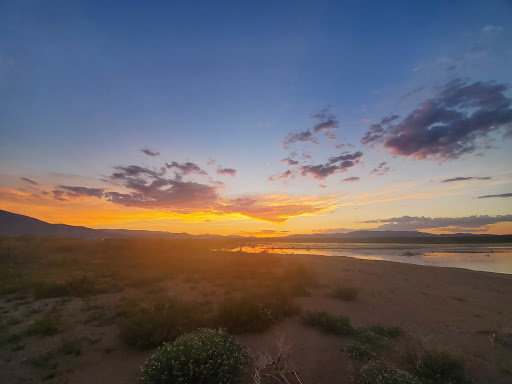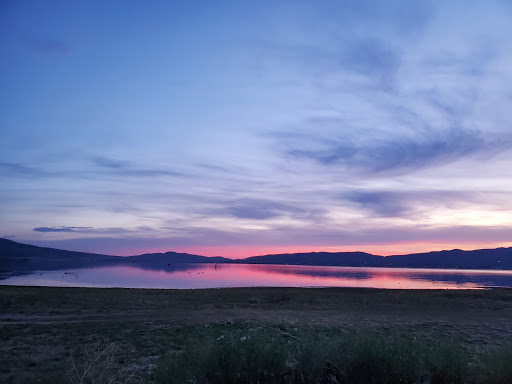There's Never a Bad Time for Birding
- Hannah Sonnenberg, SSP Program Manager
- Oct 19, 2020
- 3 min read
There’s never a bad time for birding. Less opportune times to be sure--driving down the freeway, for instance, or when you’re supposed to be participating in a virtual meeting, but your hummingbird feeder is right outside your window. Or on a different scale, the hot, sleepy midday hours, when birds, and motivation, seem to take a siesta. And as summer comes to a close, some might think that it is not an opportune time to be birding. Our backyard birds appear to have disappeared from our feeders, most of the beautiful bird song that serenaded us for months is now quiet, and the concentrated rush of Spring Migration has long passed.
But there’s never a bad time for birding.

And, in fact, late summer offers up birds and birding opportunities that aren’t possible at other times. We are in the throes of Fall Migration--the lingering to Spring’s concentrated, the drawn-out to Spring’s compressed. Diffuse and protracted, “fall” migration can start as early as June for some species, and continues far into the winter month for others. After a consolidated and frantic spring migration and a summer of trees and marshes full of the sounds of singing males and begging youngsters, this time can seem quiet and empty in comparison. After all, many of the locals are flying south. But the mass movement of migrants as they journey south from their breeding grounds to their wintering grounds means seeing birds that you may otherwise never be able to, and seeing some of those that make the most amazing and lengthy trips in our hemisphere.
The Truckee Meadows bridges a small gap between the Sierra Nevada and the Great Basin, making it an ideal place to find a wide diversity of avian taxa. Summer months come with bright yellow warblers, pink-legged marsh birds, and fast flying hummingbirds, who all utilize different pieces of our local habitat in order to breed and raise young before returning south.

Black-necked Stilt
Photo by Ben Sonnenberg

There are, however, a number of species that simply use the Truckee Meadows as a stopover in their journey, spending a few days refueling and resting before flying on. This applies to many shorebird species such as the Western, Least, Pectoral, and Baird’s Sandpipers. These small, nondescript, brown-gray birds gather in mixed flocks on local mudflats, wildly dashing about hunting for insects and other mud-dwelling invertebrates for several days before continuing their nighttime flights.
While some species are seen in the Truckee Meadows both as they fly north in the spring and south in the fall, fall migration is a particularly good time to see many of these long-distance migrant shorebird species--especially the Baird’s Sandpiper, with sightings in our county being almost exclusively limited to between August and October. (In fact, during the second week of October I was lucky enough to see three Baird’s Sandpipers on the mudflats at the Proposed Truckee Meadows Nature Study Area!)

Western Sandpipers at Swan Lake NSA
Photo by Ben Sonnenberg
The Baird’s Sandpiper (Calidris bairdii) was named after Spencer Fullerton Baird, a previous Secretary of the Smithsonian, by one of his mentees. Its genus Calidris roughly translates to gray speckled waterbird and is a much more apt description for this 7.5 inch, long-winged, and speckle-backed traveler. This species mainly bypasses Nevada on its spring journey north to the Arctic tundra, where it nests on rocky outcroppings blending into patches of lichen. However, as they return south after breeding, Baird’s Sandpipers often stop to take breaks in local areas such as Swan Lake Nature Study Area in Lemmon Valley or along the shores of Washoe Lake State Park before returning as far south as Tierra del Fuego on the very tip of South America. In total, Baird’s Sandpipers can travel more than 9,000 miles from their breeding grounds to their wintering grounds--only to turn around and fly 9,000 miles back a few short months later.

Baird’s Sandpiper Photo by Ben Sonnenberg
This amazing species remains highly mysterious with only a handful of studies describing its habits and behavior. In fact, it was one of the last sandpiper species to be classified in North America.
The Baird’s Sandpiper is just one example of the many travelers that you could see right here in Nevada during the fall months. So, if you miss the sweet cries of orioles or the buzz of a hummingbird in your garden, go out to the mudflats of Swan Lake NSA or Damonte Ranch Wetlands or Washoe Lake State Park to take a peek around for these incredible shorebirds who only grace Nevada shores several times a year during their epic journeys. After all, it’s never a bad time to be with the birds.






































Gemwin – Cổng game bài đổi thưởng có số lượng game lớn nhất hiện nay. Gemwin tặng code cho tân thủ khi đăng ký thành công, thưởng mức cao nhất thị trường.
Hitclub là một trang đại lý cấp 1 của cổng game bài đổi thưởng hitclub. Khi anh em đăng ký hoặc tải trang tại cổng playhitclub.info sẽ được nhận các khuyến mãi hấp dẫn chỉ riêng playhitclub.info cũng cấp cho anh em thêm một số vốn để đầu tư được thắng lợi lớn...
iwin club là một cổng game bài đổi thưởng tại thị trường cá cược trực tuyến Việt Nam. IWIN CLUB cung cấp các trò chơi giải trí trực tuyến như: game bài, bắn cá, nổ hũ, xổ số, bóng đá..... Các trò chơi được hoạt động trên nền tảng hiện đại và mượt mà nhất trong thị trường.
fa 88 được biết đến là cổng game cá cược giải trí đứng đầu trên thị trường hiện nay. Sân chơi này luôn nhận được sự ủng hộ khá lớn từ người chơi trên khắp đất nước Việt.
SANVIP Club là một trong những nền tảng chơi game bài đổi thưởng và nổ hũ đổi thưởng uy tín, cung cấp cho người chơi trải nghiệm giải trí thú vị với cơ hội giành giải thưởng lớn.